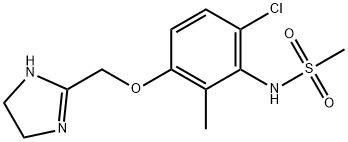219311-44-1
 219311-44-1 結(jié)構(gòu)式
219311-44-1 結(jié)構(gòu)式
基本信息
N-[6-氯-3-[(4,5-二氫-1H-咪唑-2-基)甲氧基]-2-甲基苯基]甲磺酰胺
Dabuzalgron
N-[6-chloro-3-(4,5-dihydro-1H-imidazol-2-ylmethoxy)-2-methyl-phenyl]me thanesulfonamide
MethanesulfonaMide, N-[6-chloro-3-[(4,5-dihydro-1H-iMidazol-2-yl)Methoxy]-2-Methylphenyl]-
| 報價日期 | 產(chǎn)品編號 | 產(chǎn)品名稱 | CAS號 | 包裝 | 價格 |
| 2025/05/22 | HY-117071 | 達(dá)布扎瓊 Dabuzalgron | 219311-44-1 | 1 mg | 352元 |
| 2025/05/22 | HY-117071 | 達(dá)布扎瓊 Dabuzalgron | 219311-44-1 | 5mg | 880元 |
| 2025/05/22 | HY-117071 | 達(dá)布扎瓊 Dabuzalgron | 219311-44-1 | 10mM * 1mLin DMSO | 968元 |
常見問題列表
α-1A adrenergic receptor
Dabuzalgron treatment increases ERK phosphorylation in a dose-dependent fashion with an
EC
50
of 4.8 μM. ERK1/2 activation contributes to the cardioprotective effects of Dabuzalgron.
Dabuzalgron (10 μM; 4 hours) protects NRVMs from cell death due to Doxorubicin (DOX).
Activation of the α1A-AR with Dabuzalgron (10 μM; 4 hours) mitigates the detrimental effects of DOX on mitochondrial membrane potential and abrogates the activation of important elements of the apoptotic response to mitochondrial damage.
Western Blot Analysis
| Cell Line: | Neonatal rat ventricular myocytes (NRVMs) |
| Concentration: | 0.1 μM, 1 μM, 10 μM and 100 μM |
| Incubation Time: | 15 minutes |
| Result: | Increased ERK phosphorylation in a dose-dependent fashion with an EC 50 of 4.8 μM. |
Dabuzalgron (10 μg/kg; oral gavage; twice daily; for 7 days; C57Bl6J wild-type or α1A-AR knockout mice) treatment protects against DOX cardiotoxicity by activating the α1A-AR. Dabuzalgron protects against the reduction in transcripts related to mitochondrial function, up-regulates PGC1α, preserves ATP content, and reduces oxidative stress in the hearts of mice treated with DOX.
| Animal Model: | Male C57Bl6J wild-type (WT) or α1A-AR knockout (AKO) mice (8-12-week-old) injected with Doxorubicin (DOX) |
| Dosage: | 10 μg/kg |
| Administration: | Oral gavage; twice daily; for 7 days |
| Result: | Preserved contractile function and reduced fibrosis after DOX administration. AKO mice treated with DOX had worse survival and more profoundly impaired contractile function than WT mice. Protected against the reduction in transcripts related to mitochondrial function, preserved ATP content, and reduced oxidative stress in the hearts of mice treated with DOX. |
